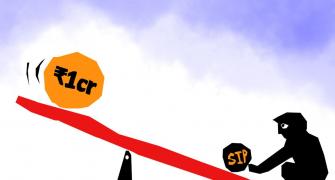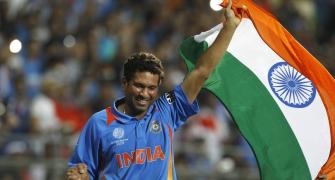.jpg?w=670&h=900) The tinsel town’s overall financial performance would have been in a bad shape if it was not for the success of the woman-oriented blockbusters, writes Urvi Malvania.
The tinsel town’s overall financial performance would have been in a bad shape if it was not for the success of the woman-oriented blockbusters, writes Urvi Malvania.
Woman-oriented Bollywood movies, it seems, are working like magic on the box office.
The producers of these films are laughing their way to the bank, thanks to the huge returns on investments (ROIs) they are getting.
At least eight movies centered around women, released between January this year and the past week -- Mary Kom, Mardaani, Queen, Ragini MMS 2 and Highway, to name a few -- have given an average return of 59 per cent to their producers.
By contrast, the 24 Bollywood films (with costs above Rs 10 crore each) released during the period, including the eight woman-centric ones, gave an average RoI of a mere 3.16 per cent. This implies the tinsel town’s overall financial performance would have been in a bad shape if it was not for the success of the woman-oriented blockbusters.
The RoI is calculated by taking into account the producer’s share in domestic box office collections and his income from sale of satellite and music rights.
Producers spent a total of Rs 185 crore on making eight female-centric movies between January and September. These movies earned close to Rs 294 crore (box office collections, satellite and music rights) -- an RoI of 59 per cent.
Among the key reasons for higher RoIs in the case woman-centric films is their low production cost. Typically, the production and advertising costs of films with star male leads -- Jai Ho, Kick, Holiday and Singham Returns, for example -- are very high.
While the average investment in female-led movies is between Rs 25 crore and Rs 27 crore, it is between Rs 100 crore and Rs 110 crore for male-led movies.
“I would define a woman-centric film as one that has a strong female protagonist (character and actor), without any star as the male lead or support. From Kahaani to Queen and more recently Mary Kom, we did not have big male stars. The cost was much more rationalised and the films were more de-risked (than the big-budget male-driven ones) at the onset. Of course, what is crucial is a concept that can be translated into great cinema,” says Ajit Andhare, COO, Viacom18 Motion Pictures.
He adds Bollywood might see more such projects as more studios begin to view movie-making through the business lens.
According to industry estimates, the budget of Queen and Mary Kom together came to Rs 55 crore.
Amrita Pandey, vice-president & head (marketing & distribution, studios), Disney India, agrees that movies with female leads, or those with strong female characters, turn out to be more profitable. She explains it is simple mathematical logic. “I would not say woman-led movies are cheap. I would say they are more profitable, as the outright fees demanded by the male actors is done away with.”
Pandey feels the trend of making films with female characters as anchors began with movies like Kahaani, No One Killed Jessica and Dor. But she says this trend took off in 2014 with as many as eight such movies already.
What is interesting is that there are more movies with strong woman roles lined up.
UTV Motion Pictures’ October 2 release Haider, an adaptation of William Shakespeare’s Hamlet and directed by Vishal Bhardwaj, has Shahid Kapoor and Tabu in key roles. Another Disney movie to hit the screens this month is Khoobsoorat, with Sonam Kapoor in the lead along side Fawad Khan. It also has meaty roles for Ratna Pathak and Kirron Kher.
“It is significant that the line between male lead and female lead movies is blurring in the minds of viewers. This is why all stakeholders in the industry have the confidence of picking up interesting concepts and actors like Shraddha Kapoor and Alia Bhatt choose to experiment with roles so early in their careers,” adds Pandey.
Since the cost of production is comparatively low, studios can invest time and resources to market these films differently.
While Pandey feels that the elements of a film should be the basis of promoting a film (and not gender of the lead), Andhare says from experience that woman-centric movies call for more aggressive and innovative ways to sell.
For example, in the case of Kahaani (2012), missing-person posters were pasted across the country.
More recently, viewers saw Priyanka Chopra in her Mary Kom avatar in an advertisement for Mother Dairy products. She was also seen promoting the finals of the Pro-Kabaddi League on Star India's channels, again in the get-up of a pugilist.
"We do not always look at brand associations for marketing these movies. It depends on the script. For Queen, we did not have so many brand associations but we played with the content to promote the film. For Kahaani, we went all out with innovations," says Andhare.
As for Mary Kom, industry estimates suggest the movie actually managed to get as many as 20 brands as associates, making another Rs 25 crore.
However, another school of thoughts is that woman-led movies need not be looked at from a different marketing lens.
"The trick lies in picking up a movie's elements and building on those. For example, in Chennai Express, though the movie had Shah Rukh Khan in the lead, the role of Deepika Padukone in promotions, as well as the film, was equally significant. In Khoobsoorat, we are not focusing only on the lead pair; the film is also being promoted by Ratna Pathak and Kirron Kher, who play important roles," says Pandey.










